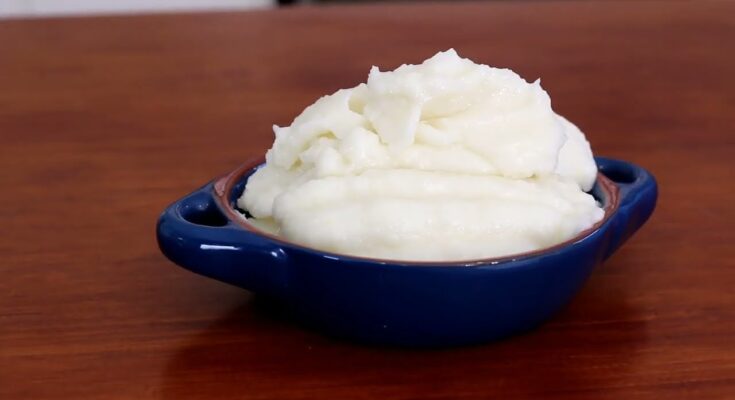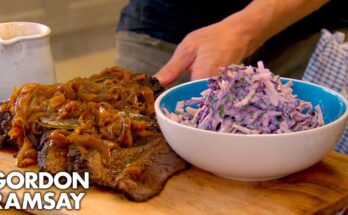Toum Recipe: Garlic lovers, rejoice! If you’ve ever had a taste of the fluffy, pungent, and utterly addictive Middle Eastern garlic sauce known as Toum, then you know it’s a game-changer. This isn’t just any condiment—this is bold, bright, and packs a punch that transforms grilled meats, veggies, sandwiches, and even fries. The best part? You can make it right at home with just a few ingredients and a blender or food processor. Stick around, because we’re diving deep into the perfect toum recipe with a step-by-step guide that’s foolproof and incredibly satisfying.
What is Toum?
Toum (pronounced “toom”) is a traditional Lebanese garlic sauce that’s whipped into a light, creamy emulsion with oil, lemon juice, and salt. Think of it as mayonnaise’s cooler, spicier cousin—except there are no eggs involved. Just pure, raw garlic goodness that’ll kick any meal up a notch.
What makes toum special is its simplicity. At its core, it’s just garlic and oil, but when done right, the result is a fluffy, airy cloud of flavor that’s got just the right amount of heat and tang. It’s vegan, dairy-free, and gluten-free, which makes it super versatile and appealing for nearly any diet.
If you’ve had shawarma, rotisserie chicken, or kebabs from a Middle Eastern restaurant, chances are you’ve dipped into this garlicky delight without even knowing what it was called. Now, imagine having that in your fridge anytime you want—yes, it’s possible!
Origins and Cultural Significance
Toum traces its roots back to the Levant region, particularly Lebanon, where it’s more than just a condiment—it’s tradition. Passed down from generation to generation, each family might have its own twist, but the core stays the same. This sauce is a staple in Lebanese households, often served alongside grilled meats, falafel, or roasted vegetables.
In many ways, toum is a celebration of garlic, which is deeply embedded in the culinary traditions of the Middle East. It’s the kind of thing that brings families together at dinner tables, food stalls, and Sunday cookouts. When you make toum, you’re not just whipping up a dip—you’re keeping a culinary legacy alive.
Why You’ll Love This Garlic Sauce
Versatility in Dishes
Toum isn’t just another sauce in the fridge—it’s a culinary sidekick that goes with just about anything. You can spread it on sandwiches, swirl it into soups for extra depth, or use it as a bold dressing for salads. Here’s how you can use toum in everyday meals:
- As a dip for pita, fries, or fresh veggies.
- Spread it on burgers, sandwiches, or wraps.
- Mix it into mashed potatoes for a garlicky twist.
- Pair it with grilled or roasted meats—chicken, lamb, beef, or even seafood.
- Toss it with roasted vegetables or use it in marinades.
The possibilities are endless. It’s like the garlic fairy left a magic potion in your kitchen.
Health Benefits of Garlic
Garlic isn’t just tasty—it’s also a superfood. Seriously, this little bulb has been used for centuries in traditional medicine, and modern science backs up a lot of those ancient claims.
Here’s why garlic is a powerhouse:
- Boosts immune function – thanks to its antibacterial and antiviral properties.
- Reduces blood pressure – studies show regular garlic consumption can help with hypertension.
- Lowers cholesterol levels – garlic helps manage LDL (bad) cholesterol.
- Anti-inflammatory effects – great for overall health and fighting off illness.
- Rich in antioxidants – which help protect your body from oxidative stress.
By whipping up a batch of toum, you’re not just spicing up your food—you’re also adding a healthy kick to your diet. Just don’t overdo it on a first date.
Ingredients You’ll Need
Basic Ingredients List
To make a classic toum, you only need a few ingredients, but their quality can make or break your sauce. Here’s what you’ll need:
- Garlic cloves (fresh, peeled) – about 1 cup
- Salt – 1 tsp (adjust to taste)
- Lemon juice – ¼ cup (freshly squeezed)
- Neutral oil – 3 to 4 cups (like canola, sunflower, or grapeseed)
- Ice water – 2-4 tbsp (helps with texture and emulsification)
That’s it! No eggs, no dairy, just pure, plant-based magic. Simplicity never tasted so good.
Ingredient Quality Tips
Now, before you go tossing everything in a blender, let’s talk quality:
- Use fresh garlic – Avoid pre-peeled or jarred garlic. Fresh cloves make a huge difference in flavor and consistency.
- Neutral oil only – Don’t use olive oil here. It’s too strong and can ruin the emulsion. Stick with canola or sunflower.
- Juice your own lemons – Bottled lemon juice doesn’t give the same bright acidity.
- Cold ingredients work better – Chilling your garlic or using ice water can help keep the emulsion stable.
Good ingredients equal great results. Trust the process, and your toum will come out perfect every time.
Essential Tools for Making Toum
Blender vs Food Processor
Here’s the million-dollar question: should you use a blender or a food processor?
Food Processor is usually preferred for this job because:
- It has more space for air to help fluff up the sauce.
- It’s easier to add oil slowly through the chute.
- Less risk of overheating the mixture.
Blender can work too, but:
- It may heat the garlic and break the emulsion.
- It’s trickier to control oil flow.
Bottom line: if you have a food processor, use it. If not, a high-powered blender will do—but you’ll need to be extra careful.
Other Helpful Kitchen Tools
To make the process smoother, here’s what else will help:
- Garlic peeler – or just smash cloves with a knife.
- Measuring cups and spoons – precision matters.
- Small bowl of ice water – to adjust consistency.
- Spatula – for scraping down the sides.
Alright, now that you’ve got everything prepped, let’s get into the fun part—actually making the toum.
Step-by-Step Toum Recipe
Step 1: Prepping the Garlic
Let’s kick things off with the foundation of this entire recipe: the garlic. This step is crucial, and rushing through it can ruin the texture or flavor of your toum.
Start by peeling your garlic cloves. You’ll need about one cup of peeled garlic, which is roughly 2–3 heads depending on their size. You can do this the old-fashioned way with a knife, or go the quick route by placing the cloves in a metal bowl, covering it with another, and shaking vigorously for 10–15 seconds. The skins should fall right off.
Now, here’s a pro tip: once peeled, soak the garlic in ice water for about 15 minutes, then pat dry. This helps mellow the harsh bite of raw garlic without dulling its flavor too much. Some people even remove the green core of the garlic cloves (especially older ones), as it can add bitterness.
Next, add the garlic and salt into your food processor. Pulse a few times to finely mince the garlic, scraping down the sides frequently to make sure everything is getting evenly chopped. The result should be a smooth, paste-like texture before you even add oil.
Why is this step important? Because the finer the garlic paste, the smoother your final sauce will be. And smooth is the name of the game when it comes to perfect toum.
Step 2: Creating the Emulsion
This is where the magic happens—and also where many people struggle. Toum is essentially an emulsion, which means you’re combining oil and water-based ingredients (like lemon juice) in a way that they don’t separate.
With your garlic paste in the food processor, it’s time to start adding the oil. But don’t go pouring it in all at once. You need to drizzle the oil in slowly, like painfully slow, one thin stream at a time. Add a tablespoon or two of oil, blend for a few seconds, then add a few drops of lemon juice. Repeat this process, alternating between oil and lemon juice in small increments.
This back-and-forth layering helps the mixture stay emulsified. If you dump in the oil too fast, the emulsion will break, and you’ll end up with a greasy mess instead of a light, fluffy sauce.
Once you’ve added about a cup of oil and all the lemon juice, check the texture. It should be thick and creamy, like a sturdy mayo. If it’s still too strong or thick, now’s the time to incorporate a tablespoon or two of ice water to lighten it up. Keep processing for a few more minutes, and your sauce should come together beautifully.
Some people find this part nerve-wracking, but don’t stress. Even if it breaks the first time, you can usually recover it by starting fresh with a small amount of garlic and slowly blending in the broken mixture like you would when fixing split mayonnaise.
Step 3: Finishing Touches
You’ve made it through the hardest part! Now it’s time to taste and tweak.
First, give it a good stir and check the consistency. It should be light, fluffy, and hold its shape when scooped with a spoon. If it feels too thick, blend in a little more ice water. Too thin? Add a little more oil slowly while processing until it firms up.
Next, taste for balance. Is it too sharp? A tiny bit of extra oil can mellow it out. Need more zing? Add a splash more lemon juice. A pinch of salt can help round out all the flavors.
At this stage, your toum should be snow-white, airy, and intensely garlicky—but not harsh or overwhelming. You want it bold but balanced.
Transfer it to a clean, airtight container and store in the fridge. It’ll last for up to 3 weeks, and the flavor actually gets better as it sits.
Bonus Tip: Make sure to clean your equipment thoroughly right after. Garlic oil can cling to everything, and nobody wants their next smoothie tasting like kebab.
How to Store and Preserve Toum
Refrigeration Tips
So, you’ve made a big, beautiful batch of toum—now what? You’ll want to store it properly to keep it fresh and delicious for as long as possible. The good news is that toum stores incredibly well in the refrigerator, thanks to its high oil content and antimicrobial properties of garlic.
Here’s how to store it like a pro:
- Use an airtight container – Glass jars with tight lids are perfect. Plastic can retain the garlic smell, so avoid it if you can.
- Label the container with the date – That way, you know exactly how long it’s been in your fridge.
- Keep it cold – Store toum in the coldest part of your fridge, ideally below 40°F (4°C).
Properly stored, toum will stay good for up to 3 weeks. And while the sharpness of fresh garlic mellows a bit over time, the flavor becomes more rounded and even tastier.
Can You Freeze Toum?
Absolutely! If you’ve made a large batch or just want to save some for future meals, freezing is a solid option. Toum holds up surprisingly well in the freezer and retains its texture and flavor after thawing.
Here’s how to freeze it:
- Use ice cube trays – Portion toum into individual cubes so you can thaw only what you need.
- After freezing – Transfer the cubes to a zip-lock bag or airtight container.
- To thaw – Place a cube in the fridge for a few hours or let it sit at room temperature until soft.
This makes it super convenient to add a burst of garlicky flavor to dishes on the fly—just pop out a cube and mix it into sauces, soups, or marinades.
Troubleshooting Common Toum Problems
Why Did My Toum Break?
One of the most frustrating things about making toum is when the emulsion breaks—meaning the oil separates and the sauce turns runny or curdled. But don’t worry, even seasoned cooks have this happen!
Here are some common reasons:
- Adding oil too quickly – The number one culprit. Always drizzle slowly.
- Overheating the mixture – Blenders can get warm fast. If the garlic heats up, the emulsion fails.
- Too much liquid at once – Balance is key. Add lemon juice and ice water a little at a time.
If it does break, all is not lost. You can fix it by starting with a fresh clove of garlic and a teaspoon of lemon juice in a clean processor. Blend it into a paste and then slowly add your broken mixture like you’re starting over. It works like a charm!
My Toum Is Too Strong – Help!
If your sauce came out too pungent or spicy, don’t panic. Raw garlic can be intense, especially when freshly blended.
Here’s how to mellow it:
- Let it sit in the fridge overnight – The flavor softens with time.
- Add a bit more oil – This dilutes the sharpness.
- Incorporate yogurt or mayo – If you’re okay with non-traditional tweaks, adding a spoonful of Greek yogurt can help balance the heat while keeping the creaminess.
Still too much? Next time, try soaking the garlic cloves in ice water for a bit longer or removing the green center from each clove.
Creative Ways to Use Toum
Beyond Dipping – Think Bigger!
Toum isn’t just for grilled meats—once you have it on hand, you’ll start finding ways to use it in everything.
Here are some fun and flavorful ideas:
- Toss it with roasted potatoes or vegetables – Just a spoonful makes everything taste like magic.
- Whisk it into salad dressings – Add lemon juice, vinegar, and a little Dijon for a killer vinaigrette.
- Swirl it into soups – Perfect for creamy soups like potato, cauliflower, or lentil.
- Spread it on pizza crust – Mix with herbs for a garlic pizza base that’ll rival any restaurant.
- Stir into scrambled eggs or omelets – Trust us, it works.
And if you’re feeling indulgent? Use it as a dip for fresh bread. The contrast of warm, soft bread and cold, pungent toum is irresistible.
Toum in Sandwiches and Wraps
One of the best uses for toum is as a sandwich spread. It’s way more exciting than mayo and adds a savory depth that pairs beautifully with roasted meats and fresh vegetables.
Try these combos:
- Chicken Shawarma Wrap – Grilled chicken, pickles, lettuce, tomatoes, and a big smear of toum.
- Falafel Pita – Crispy falafel balls, tahini, and toum for the ultimate flavor burst.
- Grilled Veggie Wrap – Eggplant, zucchini, bell peppers, arugula, and toum for a hearty vegan option.
It’s also excellent in burgers or paninis. Just remember—a little goes a long way!
Nutritional Facts and Considerations
How Healthy Is Toum?
Toum may be rich in flavor, but it’s surprisingly clean when it comes to ingredients. It’s made with just garlic, oil, lemon juice, and salt—no preservatives, no hidden additives. That said, like any high-fat food (since it’s oil-based), moderation is key if you’re watching your calorie intake.
Here’s a rough estimate of the nutritional value per tablespoon of toum:
| Nutrient | Amount |
|---|---|
| Calories | 90-100 |
| Fat | 10-11g |
| Saturated Fat | 1g |
| Carbohydrates | 1-2g |
| Protein | 0g |
| Sodium | 50-70mg |
Allergen and Dietary Info
- Vegan & Vegetarian: 100% plant-based, no animal products whatsoever.
- Gluten-Free: Safe for anyone with gluten sensitivities.
- Nut-Free: No risk for nut allergies.
- Dairy-Free: No butter, milk, or cream.
Toum is not only delicious—it’s accessible for almost every diet. Just be mindful of your portion size due to its richness.
Toum Variations and Flavor Twists
Spicy Toum
Want a fiery kick? Add a chili or two (like red Thai chili or jalapeño) when you start blending the garlic. Or stir in some harissa or chili oil once it’s done for a spicy twist. This version goes great with grilled meats or falafel.
Herb-Infused Toum
Love fresh herbs? You can blend in parsley, cilantro, basil, or even dill to create a green garlic sauce that’s visually stunning and flavor-packed. Add the herbs in the final stage of blending to keep the color bright and vibrant.
Lemon Zest & Citrus Toum
If you’re a citrus lover, add some lemon zest for an extra tangy, aromatic punch. Or swap half the lemon juice for lime juice for a slightly different zing. It’s an easy way to customize your batch and keep things exciting.
Serving Ideas for All Occasions
Whether you’re planning a BBQ, a party spread, or a weeknight dinner, toum can elevate the menu. Here are a few crowd-pleasing ideas:
- BBQ Party: Serve toum with grilled kebabs, pita, and salads.
- Game Day: Offer it as a dip for fries, chips, or chicken wings.
- Brunch: Use it in breakfast wraps, egg dishes, or even as a base for avocado toast.
- Holiday Spread: Add it to your charcuterie board next to hummus and baba ghanoush.
Whatever the occasion, toum is the garlicky MVP that steals the show.
FAQs about Toum Recipe
What is Toum made of?
Toum is a traditional Lebanese garlic sauce made with garlic, oil, lemon juice, and salt. It’s completely vegan and has a fluffy, creamy texture.
Is Toum the same as aioli?
While similar, Toum is not the same as aioli. Toum uses raw garlic as the main ingredient, while aioli often includes egg yolks. Toum is more pungent and has a stronger garlic flavor.
Why did my Toum break or separate?
Toum can break if the oil is added too quickly or if the garlic and lemon juice aren’t emulsified properly. Always drizzle oil slowly and blend patiently for the best results.
How long does Toum last in the fridge?
Stored in an airtight container, Toum can last up to 3–4 weeks in the refrigerator. Its flavor deepens over time, making it even better with age.
Can I freeze Toum?
Yes! You can freeze Toum in small portions using an ice cube tray. Once frozen, transfer the cubes to a sealed bag or container for up to 3 months.
What do you eat Toum with?
Toum pairs beautifully with grilled meats, roasted vegetables, shawarma, falafel, and even fries. It also works as a bold sandwich spread or dip.
Conclusion
There you have it—your ultimate, step-by-step guide to mastering toum, the bold and creamy Lebanese garlic sauce that’s guaranteed to become a staple in your kitchen. It’s easy to make, incredibly flavorful, and pairs with just about everything.
Once you’ve tried homemade toum, there’s no going back. Its rich, tangy, garlicky goodness will have you reaching for it again and again. So go ahead—grab that garlic, fire up your food processor, and whip up a batch. Your taste buds will thank you.



